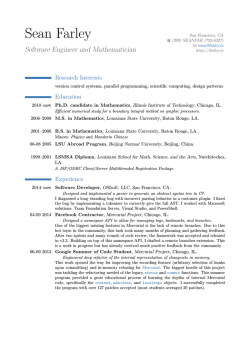
Winter 2015 - Louisiana Native Plant Society
LNPS Winter 2015 Volume 29, Issue 1 Inside this issue: President’s Corner 2015 Annual Meeting Monarch Butterfly Proposed for Federal Listing Did you know... 1 2-4 Louisiana Native Plant Society News 5 6-7 Field trip information and map 8 2015 Annual Meeting Registration Form 9 LNPS Membership Form 9 LNPS Officers LNPS Officers: Bud Willis, President Peggy Cox, Vice-President Beth Erwin, Secretary Jackie Duncan, Treasurer David Moore, Newsletter Editor Bob Dillemuth, Past President Will deGravelles, Interim President CANPS Board Expiring 2015: Jim Foret | Annette Parker | Charles Allen Board Expiring 2016: Linda Chance | Charlotte Seidenburg | Betty Miley Board Expiring 2017: Rick Webb | Matthew Herron | Dave Banowetz President’s Corner by Bud Willis You will see attached in this newsletter our annual program for this year. I believe we have a good lineup. Greg Grant and Gail Barton, old friends of the LNPS, will talk about natives in the home landscape, Richard Johnson will talk about the early history of LNPS and the common background of LNPS and Briarwood, and Fred Nation will discuss the relatively newly discovered Rhododendron colmanii. Our business meeting should be short this year unless someone has a lot on their mind, but I will try to keep a rein on things. One thing I would like you to think about is the program for next year, 2016. One idea that I think is a good one is low maintenance, native lawns. This is a trend that I think is bubbling to the surface and for good reason. Please bring your ideas up. Our non-native Camellias keep us in color this time of year. Our sasanquas are near the end of their bloom season but have been beautiful starting before Thanksgiving and extending through the Christmas season. With the early blooming japonicas in full form, the rest of the japonicas will keep us in wonder for the rest of the winter, if we don’t get an exceptional freeze. Our natives around our place mainly appear to be resting now, except beneath that stark form they are preparing for spring and huge buds are on our spring blooming native azaleas. The later blooming ones such as Rhododendron prunifolium are barely showing their buds. We have the eight native azaleas that perform well in our area, a fair number of cultivars, and 15 hybrids, most of which are bursting with buds. They are all preparing for my favorite time of year when they will be in full bloom, with some of the species extending into June and perhaps July. Another shrub that has become one of my favorites is the possumhaw viburnum (Viburnum nudum). And of course all the “C” natives: Cercis, Chionanthus, Clethra, Cliftonia, Cornus, Cotinus, and Crataegus. It looks like a spectacular spring is in the making and I cannot wait. Page 2 Louisiana Native Plant Society Volume 29, Issue 1 Winter 2015 Annual Meeting January 30-31, February 1, 2015 Camp Hardtner, Pollock, LA For the tenth year, LNPS members will return to Camp Hardtner, located in the piney woods of central Louisiana, north of Pollock, La. Fishing is available in the pond at the Camp and there is a wonderful deck that overlooks the pond where visiting and drinking coffee can be enjoyed. No boats are allowed and alcoholic beverages are not permitted on the grounds. The costs for lodging and food are shown below. Please complete the registration form and return to Jackie Duncan at the address indicated by January 24, 2015. Friday, January 30, 2015 5:00 pm till – Registration will be from 5 till 6 pm followed by a potluck supper in the dining hall. Bring your favorite dish along with your favorite plant slides. Favorite slides will be shown during and after the meal. Book sales and plant swapping will also start and continue into the weekend. Laptop, projector, and screen will be provided. Saturday, January 31, 2015 7:00 am: BREAKFAST 8:30 am – Program I: “Rhododendron colmanii” by Fred Nation. Fred is an environmental consultant, free-lance photographer and writer, who lives in Daphne, Alabama with his wife Maureen. Major activities include plant inventories, site assessments and restorations, nature trails, and the control of invasive exotic plant species. He has developed nature trails and field guides for the Cities of Daphne and Fairhope, Blakeley State Park, Weeks Bay Reserve, Camp Beckwith, and the Baldwin County Parks and Recreation Department. Fred teaches regular seminars on habitats and ecosystems for Weeks Bay Reserve. He conducts frequent workshops on invasive exotic plant controls and plant identification for the USDA Forest Service, The Cooperative Extension System, and Weeks Bay Reserve. He has identified and nominated 25 Alabama State Champion Trees, and Fred is on the Board of Directors of Historic Blakeley State Park. He is the author of the book, Where the Wild Illicium Grows; Historic Plants of South Alabama and the Central Gulf Coast. 9:15 am – Program II: “Backyard Wildflower Propagation” by Gail Barton. Gail taught Plant Propagation for over two decades and propagated plants for her own Flowerplace Plant Farm. She currently maintains a small nursery where she contracts to grow wildflowers. Recently she propagated Black Belt Prairie wildflowers and grasses used to establish a Prairie Garden at The University of West Alabama. Gail works as a Landscape Consultant, teaches Propagation Workshops and blogs at www.yardflower.com. She is past president of the Mississippi Native Plant Society and is a certifiable plant fool. She enjoys exploring her six acre home place in Meridian, Mississippi with her husband and pack of happy dogs. BREAK 10:00 – 10:15 10:15 am – Business Meeting Business Meeting Agenda I II III Call to order Minutes call for approval Report of Committees: A: Treasurer’s Report. - Jackie Duncan B: Grant Committee Report - Peggy Cox (Brian Early, Chris Doffitt, Matt Herron) Page 3 Louisiana Native Plant Society C: Volume 29, Issue 1 Logo committee report - Matt Herron (& Beth Erwin, Tracy Banowitz) IV Appointments / Reappointments / Reports: A: Grant Committee - Peggy Cox, Brian Early, Chris Doffitt, Matt Herron B: Logo: - Did we finish this year? If not: Matt Herron, Beth Erwin, Jackie Duncan. C: Nominating - Beth Erwin, Jackie Duncan, Peggy Cox, Baton Rouge chapter president, Rick Webb, G.W. Willis (non-voting chair) V VI VII VIII IX X Chapter reports Set meeting time / place for 2016 Field Trip suggestions / ideas Recognition of lost members Announcements Ask for motion to close meeting 11:00 am – Program III: “History of Briarwood and Associated History of LNPS” by Richard Johnson. Richard was born in the Readhimer community where he grew up. From a young age he knew Caroline Dormon as she was a close neighbor and friend of the family whose property he passed through on his way to and from the local country store. Miss Carrie was held in high esteem by the family, particularly by a young man who loved to read, for she had a library of great books to thrill and enlighten the mind. After graduating from school Richard went to college at the University of Southwestern Louisiana in Lafayette, now known as University of Louisiana Lafayette. Life has brought him many experiences; a few are: working cutting and making crossties, on a bridge crew, foreman of the Foremost ice cream plant in Shreveport and electrician and head of maintenance for Martin Timber Company in Castor. Shortly before her death in 1970 Caroline Dormon called Richard and asked him to come see her; that evening she laid out for him her dream of the future for Briarwood. In a tone that left the option to decline out of the question she asked him to become the first curator of Briarwood. After her death and with the establishment of the Foundation for the Preservation of the Caroline Dormon Nature Preserve Inc. he began a labor of love and dedication to the preservation and growth of Briarwood that continues to this day. He met and married Jessie Johnson and had two children, Richard M Johnson and Caroline Ann Johnson 11:45 am – LUNCH 1:00 pm – Program IV: “Native Perennial Plants in the Home Landscape” by Greg Grant. Greg is a horticulturist, conservationist, and writer from Arcadia, Texas. He lives in deep East Texas in his grandparent’s restored dogtrot farmhouse where he tends a small cottage garden full of old fashioned flowers, the Rebel Eloy Emanis Pine Savanna and Bird Sanctuary, a rare stand of Trillium recurvatum, and terriers Acer, Ilex, and Lizzie. His real job, however, is at the Stephen F. Austin State University Pineywoods Native Plant Center in Nacogdoches, Texas. 2:00 pm – Native Plant Auction (Funds from the auction are used to fund the annual LNPS grants given to students and organizations for native plant projects.) Sunday, February 1, 2015 7 am – Coffee in dining hall. Anyone who wishes may bring sweet rolls, etc. 8:30 am – Morning field trip will depart from the dining hall at Camp Hardtner. This year’s trip will be to the Croker Study site. See map on page 8. Page 4 Louisiana Native Plant Society Volume 29, Issue 1 Directions to Camp Hardtner: Camp Hardtner’s address is 2393 Camp Hardtner Rd., Pollock, LA 71467-4183. It is located to the east of U.S. Highway 165, eight miles north of Pollock in Grant Parish. The entrances to the side road that loops to the camp are near Mile Markers 103 and 109 on U.S. Hwy. 165. The loop is about 8 miles long and the Camp is midway, literally straddling the road. The loop is rough, so travel cautiously. Page 5 Louisiana Native Plant Society Volume 29, Issue 1 U.S. Fish and Wildlife Service Initiates Status Review of Monarch Butterfly under the Endangered Species Act December 29, 2014 Contact: Vanessa Kauffman, 703-358-2138, [email protected] The U.S. Fish and Wildlife Service today announced it will be conducting a status review of the monarch butterfly under the Endangered Species Act (ESA). The Service has determined that a petition from the Center for Biological Diversity, the Center for Food Safety, the Xerces Society for Invertebrate Conservation and Dr. Lincoln Brower to list a subspecies of monarch (Danaus plexippus plexippus) presents substantial information indicating that listing may be warranted. Monarch butterflies are found throughout the United States and some populations migrate vast distances across multiple generations each year. Many monarchs fly between the U.S., Mexico and Canada – a journey of over 3,000 miles. This journey has become more perilous for many monarchs because of threats along their migratory paths and on their breeding and wintering grounds. Threats include habitat loss – particularly the loss of milkweed, the monarch caterpillar’s sole food source – and mortality resulting from pesticide use. Monarch populations have declined significantly in recent years. The Service will now conduct a status review to determine whether listing is warranted. To ensure this status review is comprehensive, the Service is requesting scientific and commercial data and other information through a 60-day public information period. Specifically, the Service seeks information including: The subspecies’ biology, range and population trends, habitat requirements, genetics and taxonomy; Historical and current range, including distribution patterns; Historical and current population levels and current and projected trends; The life history or behavior of the monarch butterfly that has not yet been documented; Thermo-tolerance range and microclimate requirements of the monarch butterfly; Past and ongoing conservation measures for the subspecies, its habitat or both; and, Factors that are the basis for making a listing determination under section 4(a) of the ESA; The notice was published in the Federal Register December 31, 2014, and it is requested that information be received by March 2, 2015. To view the notice and submit information, visit www.regulations.gov docket number FWS-R3-ES-20140056. For more information on the ESA’s petition process, visit http://www.fws.gov/endangered/what-we-do/listing-petitionprocess.html. Page 6 Louisiana Native Plant Society Volume 29, Issue 1 Did you know that spore dispersal in most mosses is aided by changes in humidity? The peristome is located around (peri-) the mouth (-stome) of the moss capsule, a structure which contains the spores. The teeth on the peristome have the ability to move in response to humidity, thus opening and closing the mouth of the moss capsule. This movement facilitates the release of spores (colored in green) under optimal dispersal conditions. For the past 200 years, peristome characteristics have played an important role in defining major groups of mosses. Below is a scanning electron micrograph of Timmia megapolitana. It has been colored to highlight the two layers of the peristome. The endostome (inner layer, colored in brown) consists of a membrane that is topped by 64 filaments, while the exostome (outer layer, colored in green) consists of 16 large teeth. Scanning electron microscope photograph of the peristome of Timmia megapolitana . 200µm = 0.2 millimeter. Image and text courtesy of J. M. Budke and the Botanical Society of America (http://pix.botany.org/media/medium/ca07-029.html). Page 7 Louisiana Native Plant Society Volume 29, Issue 1 The peristome teeth are triangular two-ply structures which operate like trap-doors. One layer tends to readily absorb or lose moisture while the other has little affinity for water. What this means is that as water is lost one side of the peristome teeth shrinks while the other does not. This results in a bending of the teeth outward. Here is a you tube video showing the opening of a moss capsule. You can clearly see the inner (endostome) and outer (exostome) teeth of the capsule. With the exception of one group of mosses (Graphite mosses), all moss capsules have an operculum and peristome. The general dispersal mechanism is as follows (see illustration bottom right). Under dry conditions: the calyptra (remnant of the archegonium) drops off the operculum is shed as a result of water loss by the annulus the peristome teeth bend outwards spores fall out of the capsule and are carried by air currents Peristomal teeth on moss capsule - species unknown. Image courtesy ohioplants.org Peristomal pores on moss capsule of Polytrichum spp. Image courtesy Ohio Moss and Lichen Association. Peristomal teeth on moss capsule - species unknown. Image courtesy Laurie Knight at http://laurieknight.net/ Generalized moss spore dispersal. Page 8 Louisiana Native Plant Society Volume 29, Issue 1 Field trip information and map to Croker Study Site. The Croker Study was a longleaf pine regeneration trial to test the success of a three-cut shelterwood and a two-cut shelterwood as a means of naturally restocking longleaf pine sites. The following table shows the various types and timing of treatments which have been applied to the study site. Fire history for the Croker Study, Compartment 30, Catahoula Ranger District, Kisatchie National Forest, LA; the reserved shelterwood was 82 years old in 2005. 1969 Winter burn competition control 1970 Fall burn (11/2/1970) seedbed 1973 Winter burn (12/1972) seedbed 1976 Winter burn (2/1976) wildfire 1977 Summer burn (8/1977) seedbed and competition control 1980 Winter burn seedbed and competition control 1982 Winter burn competition control 1983 Summer burn seedbed and competition control 1987 Fall burn (10/1987) seedbed and competition control 1991 Winter burn (2/1991) competition control 1993 Spring burn (5/1993) competition control 1996 Fall burn (10/1996) competition control 1999 Spring burn (6/1999) competition control 2001 Spring burn (5/19/2001) competition control 2003 Spring burn (5/28/2003) competition control 2005 Spring burn (4/20/2005) competition control 2006 April or May burn RCW habitat-Competition Control 2008 April or May burn RCW habitat-Competition Control 2010 April or May burn RCW habitat-Competition Control 2012 DID NOT BURN DUE TO DROUGHT Page 9 Louisiana Native Plant Society Volume 29, Issue 1 2015 Annual Meeting Registration Form Remittance Registration ______Free____________ Saturday Meals: Breakfast $7.00/person (7:30 am) ______________________ Lunch $8.00/person (noon) ______________________ Dinner Leftovers from Potluck (5:30 pm) ______________________ Lodging: Holy Day Inn $55 single; $70 double/night ______________________ Cabins $20/person/night, bring your linens ______________________ Please indicate which nights you will be staying: Friday _____ Saturday _____ bb Annual Dues (form below): ______________________ Check address label for expiration date TOTAL ______________________ Please submit your registration and payment by January 24, 2015. Checks payable to LNPS. Send to: Jackie Duncan, 114 Harper Ferry Road, Boyce, LA 71409 LNPS Membership Form Membership Form: Name: Email: Checks payable to LNPS. __________________ Phone: _____ __________________________________________________________________ Address: City: State: Zip: Annual Dues: Student/Senior $5_____ Individual $10_____ Family $15_____ Organization $25_____ Sustaining $50_____ Corporate $100_____ Mail to: Jackie Duncan, 114 Harper Ferry Road, Boyce, LA 71409 LNPS The Louisiana Native Plant Society was founded in 1983 as a state-wide, non-profit organization. Its purposes are to preserve and study native plants and their habitats, to educate people on the value of native plants and the need to preserve and protect rare and endangered species, to promote the propagation and use of native plants in the landscape, and to educate people on the relationship between our native flora and wildlife. Louisiana Native Plant Society 114 Harpers Ferry Road Boyce, LA 71409 Phone: 318-793-8064 E-mail: [email protected] www.lnps.org Louisiana Native Plant Society Jacalyn Duncan 114 Harpers Ferry Road Boyce, LA 71409 «AddressBlock» Expires: «Department»
© Copyright 2026





